The Roussillon
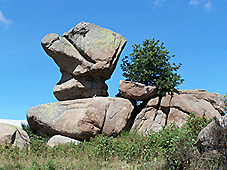 The Roussillon is quite a different part of France, as it has been a part of Spain up to the mid 17th century. Only in 1659 the Roussillon, which was then called Catalonia, was divided into two parts at the 'Treaty of the Pyrenees'.
The Roussillon is quite a different part of France, as it has been a part of Spain up to the mid 17th century. Only in 1659 the Roussillon, which was then called Catalonia, was divided into two parts at the 'Treaty of the Pyrenees'.With the Treaty of the Pyrenees on 7th November 1659 there came an end to the Spanish-French conflicts which had been the result of the Thirty Year War. Both countries now agreed on a new border, and Spain surrendered the Roussillon, a part of Navarra and the northern part of the Cerdagne to France.
And so, Spanish Catalonia and French Catalonia came into existence. The area, however, never lost its Spanish identity. Also the climate is dryer and hotter in comparison to the other parts of France. The coastal towns are characterised by the presence of many thick old palmtrees alongside the boulevards and also the cuisine is more Spanish orientated than French. And not to forget, still many people speak Catalan among themselves.
The coastal strip is very popular with sun worshippers. Seaside resorts such as Canet Plage and Argeles-sur-Mer do have lots to offer. There is a tropical feel to the beaches, there are lots of souvenir shops and restaurants and there is a very long beach which doesn't go down too steeply into the sea, so the Roussillon coast is very ideal for families with little children.
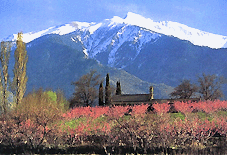 Also inland no one will ever get bored. The green Corbière and the Pyrenees are perfect for walks and hikes. Here one can still find impressive unspoilt nature, flanked by the high mountains of the Pyrenees and the sacred mountain Canigou, which has a very special place in the hearts of the Catalans. And apart from that, the Roussillon has an impressive history which has left its marks on the land. For centuries the area was inhabited by Romans and Visigoths. After the Muslim occupation the Roussillon was officially added to the Holy Roman Empire. However, the Roussillon was largely ruled by appointed feudal lords with lots of power, and these people were usually descendants of important noble families and often from Visi- or Ostrogoth descend. After the Treaty of the Pyrenees, when the Roussillon officially became French, it was given the name Pyrénées-Orientales.
Also inland no one will ever get bored. The green Corbière and the Pyrenees are perfect for walks and hikes. Here one can still find impressive unspoilt nature, flanked by the high mountains of the Pyrenees and the sacred mountain Canigou, which has a very special place in the hearts of the Catalans. And apart from that, the Roussillon has an impressive history which has left its marks on the land. For centuries the area was inhabited by Romans and Visigoths. After the Muslim occupation the Roussillon was officially added to the Holy Roman Empire. However, the Roussillon was largely ruled by appointed feudal lords with lots of power, and these people were usually descendants of important noble families and often from Visi- or Ostrogoth descend. After the Treaty of the Pyrenees, when the Roussillon officially became French, it was given the name Pyrénées-Orientales.Culture lovers will enjoy visiting the wonderful old abbeys, medieval towns or castles. Catalonia was one of the most important realms of the Mediterranean. The Balearic Islands and the Roussillon were part of this realm. About 80 years (1261 - 1279/1344) the Roussillon and the Balearic Islands formed the more or less independent kingdom of Mallorca, with Perpignan as its capital.
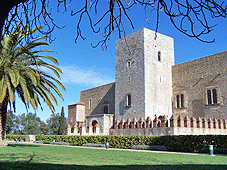 Perpignan
PerpignanPerpignan is a nice town with many little streets. Several beautiful houses downtown are witnesses of the earlier economical golden age. The Palace of the kings of Mallorca was built between the 13th and 14th century and is the oldest royal residence in France. It was built after Jacques le Conquérant (the conqueror) decided to turn Perpignan into the capital of the kingdom of Mallorca. The Citadel, of which a part has survived the ages, looks out onto the city.
Perpignan has several interesting churches, such as the Notre Dame Ste Marie la Réal, a typical example of southern Gothic style. The Eglise St. Jaques dates from the 14th century and has been partly built onto the ancient city walls. And not to forget the cathedral, St. Jean Baptiste.
The town centre is characterised by the Place de la Loge with its beautiful old buildings, such as the old town hall and the old courthouse (Loge de la Mer) from the 14th century. On Place Verdun we find Le Castillet from the 14th century. This was the place from which Perpignan was defended. It now houses an interesting district museum. The annual fireworks are fired from the area around the Castillet on 23rd June, the feast day of St. John the Baptist.
On Place Armand Lanoux you will find the Tourist Information Centre. There are often markets downtown, like the Summer fleemarket on Sundaymornings (Palais des Expositions). In the period that Spain and France were fighting for the ownership of the Roussillon, the Fort de Salses, situated a little bit north of Perpignan, played an important role. The fortress was built in 1497 by king Fernando of Aragon. The fortress is buried halfway into the ground and is a good example of Spanish military architecture. The building is well preserved and worth a visit. The tour takes about 45 minutes.
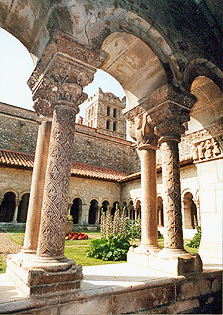 The ancient town of Elne goes back a long way back in history. The Romans never gave it too much attention, they named it Illiberis. In the 4th century the christian emperor Constantine the Great rebuilt the citadel and named the town after his mother, Helena.
The ancient town of Elne goes back a long way back in history. The Romans never gave it too much attention, they named it Illiberis. In the 4th century the christian emperor Constantine the Great rebuilt the citadel and named the town after his mother, Helena. In the mid 5th century, the bisshop came to Elne. The town would remain the bisschop's seat until 1602, when it moved to Perpignan. The cathedral St. Eulalie is definitely worth a visit, parts of the church date back to the 11th century. However, the absolute stunner is the attached monastery with its magnificent pillars, of which none is alike. In the monastery you will find a small but lovely archaeological museum.
The village itself is perfect for walks along the ancient streets and from the ramparts you have a wonderful view over the village and the landscape beyond.
 You could for instance visit Elne in the morning, drive to one of the seaside restaurants for a freshly baked fish and then spend the hot hours of the afternoon on the beach. Close to Elne you will find Canet-Plage or Argeles-sur-Mer, both with a lovely broad sandy beach. You can walk along the boulevard with its ancient palmtrees, shop around in the souvenir shops and indulge yourself on a terrace with a large sorbet in front of you before you try the clear waters of the Mediterranean.
You could for instance visit Elne in the morning, drive to one of the seaside restaurants for a freshly baked fish and then spend the hot hours of the afternoon on the beach. Close to Elne you will find Canet-Plage or Argeles-sur-Mer, both with a lovely broad sandy beach. You can walk along the boulevard with its ancient palmtrees, shop around in the souvenir shops and indulge yourself on a terrace with a large sorbet in front of you before you try the clear waters of the Mediterranean.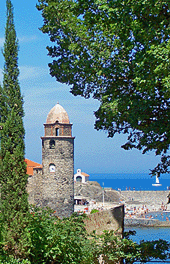 Picturesque Collioure with its Templar castle is one of the loveliest towns on the Vermeille coast. From the cute little harbour you can stroll trhough the ancient streets and shop for special gifts and art. This is one of the coastal towns immortalised by some of the world's most famous art painters, who came here around 1900 for the light and the atmosphere. There are several interesting museums.
Picturesque Collioure with its Templar castle is one of the loveliest towns on the Vermeille coast. From the cute little harbour you can stroll trhough the ancient streets and shop for special gifts and art. This is one of the coastal towns immortalised by some of the world's most famous art painters, who came here around 1900 for the light and the atmosphere. There are several interesting museums.Tip: Collioure is very populair. Go early in the morning to have a parking spot. In Summer you can also travel to the nearest town and take a ferry (hop on hop off) from e.g. Port Vendres or Argelès-sur-Mer to Collioure.
When you go further south along the coastline, the beaches become more rocky with stones and rocks.
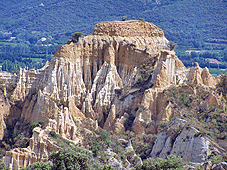 Nature lovers will love the Vallée de la Têt. The Têt is a river which flows into the Mediterranean near Perpignan and originates at the foot of the Pic Carlit, not far from Font Romeu in the Pyrenees. In the mean time, the river flows through a lovely valley. You can visit the organ pipes near Ille-sur-Têt, strange eroded rocks that look like organ pipes. The surrounding landscape is breathtaking! Also, in Tautavel you can visit a museum and learn all about the oldest European, which was named Tautavel Man (see the webpage on the Corbière).
Nature lovers will love the Vallée de la Têt. The Têt is a river which flows into the Mediterranean near Perpignan and originates at the foot of the Pic Carlit, not far from Font Romeu in the Pyrenees. In the mean time, the river flows through a lovely valley. You can visit the organ pipes near Ille-sur-Têt, strange eroded rocks that look like organ pipes. The surrounding landscape is breathtaking! Also, in Tautavel you can visit a museum and learn all about the oldest European, which was named Tautavel Man (see the webpage on the Corbière).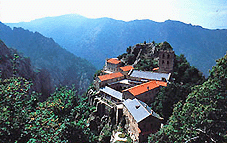 Near the sacred mountain Canigou you will find the 11th century monastery St. Martin du Canigou. In the area you can make lovely walks through the mountains. The abbey itself is back in function and visits can only be made on appointment. The most important part of the abbey is, however, its spectacular location, which you can observe while walking in the area.
Near the sacred mountain Canigou you will find the 11th century monastery St. Martin du Canigou. In the area you can make lovely walks through the mountains. The abbey itself is back in function and visits can only be made on appointment. The most important part of the abbey is, however, its spectacular location, which you can observe while walking in the area. Prades is an old town in the fertile valley of the Têt river at the northern slope of the Canigou. In the church St. Pierre you can see a very mysterious black Christ. There is a market on Tuesdays in the Allées Arago around the church.
In the surroundings of Prades is another site you must see when visiting the Roussillon; the abbey of St. Michel de Cuxa. The abbey was founded in 974 and in the Middle Ages it was one of the most important abbeys in Catalonia. There is a very famous music festival in July and August. Tickets can be purchased at the local Tourist Office.
You can also take a breathtaking walk through the Gorge of Carança. Part of the path has been hewn out of the cliff.
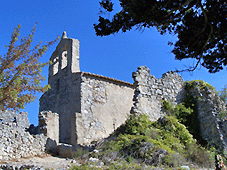 Another interesting site is the mysterious haunted village of Perillos. There are many stories which are connected to the Grail legends. There is even an organisation which studies the strange site, called Societé Perillos. Some people believe that Joseph of Arimathea was buried here.
Another interesting site is the mysterious haunted village of Perillos. There are many stories which are connected to the Grail legends. There is even an organisation which studies the strange site, called Societé Perillos. Some people believe that Joseph of Arimathea was buried here.And of course the Roussillon is full of impressive Cathar Castles (see the webpage "The Cathars" for more information). Visit for instance Peyrepertuse or Queribus, the two more famous of the Cathar Castles. But there are many more less known fortresses with equally interesting stories....
It is clear that visiting the Languedoc without making at least one daytrip into the Roussillon, is not complete. It pays to get lost, as this is the right way to discover unspoilt natural beauty, ancient villages, mysterious ruins of old castles and breathtaking views. A unique part of France!!